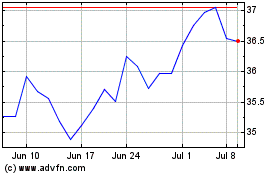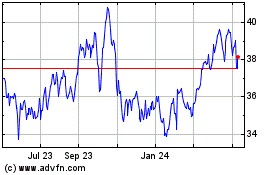Top executives at Riverstone Holdings LLC, one of the world's
largest energy investment firms, have ceded more than $300 million
of profits they made from investments before the oil bust erased
those gains, according to securities filings and people familiar
with the matter.
The money is related to an incentive formula employed at
private-equity firms in which executives earn a cut of profits
above a certain threshold for each fund.
In Riverstone's case, profits in some of its funds shriveled
after U.S. oil prices plunged to below $27 a barrel earlier this
year from more than $100 in mid-2014. That decline reduced the
value of some companies owned by Riverstone, eliminating paper
gains and requiring some executives to return profits in a
so-called clawback.
David Leuschen and Pierre Lapeyre Jr., who founded Riverstone
and remain its majority owners, are the primary recipients of its
portion of deal profits, known as carried interest. Through a
spokesman, Messrs. Leuschen and Lapeyre declined to comment.
While most private-equity funds usually keep details of their
fund performance and structure private, industry executives say
clawbacks are rare. Most firms want to avoid having to recall
payments made to executives, some of whom may have left the firm or
already spent the cash.
What's more, diversified private-equity firms make investments
across a number of sectors that balance a fund's results; losses on
one deal can be offset by profits on another.
But funds that focus on oil and gas, which exploded in
popularity since the start of the shale boom, have become
particularly vulnerable to big swings in performance because their
profits are highly susceptible to changes in energy prices.
David Fann, chief executive of TorreyCove Capital Partners LLC,
which vets private funds for investors, said clawbacks in energy
funds are becoming more common as low oil prices continue to pummel
investments made when prices were much higher. "It's the new normal
for investors in oil funds," he said. "They're realizing the
challenges of oil volatility."
A clawback is a feature of private-equity funds intended to
assure investors they will earn a minimum return, often 8%, before
the fund managers take their share of the profits—and that fund
investors won't be left holding the bag if investments lose value
after fund managers cash out of early successful deals.
The mechanics vary from firm to firm, but many pay out deal
profits as they are earned and don't repay them until the end of a
fund's life, which is often 10 years or more.
It's unclear how much, if any, cash Riverstone executives
personally have had to surrender back to the fund. They could hold
off until the fund is liquidated, hoping that oil prices bounce
back and their debts are erased. The firm typically holds a portion
of its deal profits in escrow to avoid having to ask executives to
repay large sums should investments lose value, according to a
person familiar with the matter.
Riverstone isn't alone in having profits slip away in the oil
bust. Private investment funds focused on oil and gas lost roughly
22% of their value in 2015, a crushing year that has negated
several prior years of gains, according to investment adviser
Cambridge Associates LLC. For the five years ended Dec. 31, such
funds have an annualized loss of 0.06%, after fees, Cambridge
says.
Riverstone was founded in 2000 by the two former Goldman Sachs
Group Inc. energy bankers as the shale boom was taking off. One of
the New York investment firm's early funds, launched in 2002,
produced annualized profits of about 55% after fees, according to
public pension records.
Money poured into subsequent funds from pensions and other
institutional investors eager to get in on the shale boom and
renewable energy, one of Riverstone's other specialties. Riverstone
became a landing spot for former Goldman bankers as well as former
oil company CEOs from firms like Anadarko Petroleum Corp. and BP
PLC. Even as crashing oil prices rippled through its holdings,
Riverstone has continued to raise billions of dollars for new
funds. Riverstone has raised $34.2 billion, since its inception,
including some $7 billion since oil prices crashed.
The firm initially partnered with Carlyle Group LP, which helped
the upstart raise money and handle back-office functions in
exchange for a stake in Riverstone's funds. That partnership lasted
for several funds before Riverstone struck out on its own for a
$7.7-billion fund it raised in 2013.
Carlyle said in a securities filing that as of June 30 it had
set aside $76 million in gains it owes back to three funds it
manages alongside Riverstone based on the investment pools' present
value.
Each of the three Riverstone funds that Carlyle says are subject
to the clawback remained profitable for investors as of June 30 but
have fallen below the minimum level of profitability that entitles
the firms to a cut of the gains. They are the only of Carlyle's 34
funds in clawback, company filings show.
When Carlyle reported second-quarter results last week, analysts
asked executives why another of its funds, which had gained enough
for the firm and its shareholders to start taking their cut, hadn't
started paying out. Carlyle's executives said they wanted to ensure
the profits were permanent lest they wind up having to return
money.
"Investors aren't happy with clawback," said Carlyle co-CEO
David Rubenstein, "but the professionals in our firm are even less
happy when we have to claw back."
Dawn Lim contributed to this article.
Write to Ryan Dezember at ryan.dezember@wsj.com
(END) Dow Jones Newswires
August 02, 2016 14:45 ET (18:45 GMT)
Copyright (c) 2016 Dow Jones & Company, Inc.
BP (NYSE:BP)
Historical Stock Chart
From Mar 2024 to Apr 2024

BP (NYSE:BP)
Historical Stock Chart
From Apr 2023 to Apr 2024
